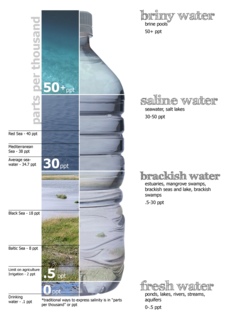
Back ماء مسوس Arabic Brackwossa BAR Саланаватая вада Byelorussian Aèr anta BEW नुनछाह पानी Bihari ঈষৎলোনা পানি Bengali/Bangla Bočata voda BS Aigua salabrosa Catalan Brakická voda Czech Brakvand Danish
| Part of a series on |
| Water salinity |
|---|
 |
| Salinity levels |
|
Fresh water (< 0.05%) Brackish water (0.05–3%) Saline water (3–5%) Brine (> 5% up to 26%–28% max) |
| Bodies of water |
Brackish water, sometimes termed brack water,[1][2] is water occurring in a natural environment that has more salinity than freshwater, but not as much as seawater. It may result from mixing seawater (salt water) and fresh water together, as in estuaries, or it may occur in brackish fossil aquifers. The word comes from the Middle Dutch root brak. Certain human activities can produce brackish water, in particular civil engineering projects such as dikes and the flooding of coastal marshland to produce brackish water pools for freshwater prawn farming. Brackish water is also the primary waste product of the salinity gradient power process. Because brackish water is hostile to the growth of most terrestrial plant species, without appropriate management it can be damaging to the environment (see article on shrimp farms).
Technically, brackish water contains between 0.5 and 30 grams of salt per litre—more often expressed as 0.5 to 30 parts per thousand (‰), which is a specific gravity of between 1.0004 and 1.0226. Thus, brackish covers a range of salinity regimes and is not considered a precisely defined condition. It is characteristic of many brackish surface waters that their salinity can vary considerably over space or time. Water with a salt concentration greater than 30‰ is considered saline. See the salinity table from the Wikipedia salinity article.
- ^ "What is brackish water and what effect does a high concentration of ammonia have?". The Laboratory People. 15 June 2012. Retrieved 21 November 2020.
- ^ Klaassen, K.; Bormann, H.; Klenke, T.; Liebezeit, G. (2008). "The impact of hydrodynamics and texture on the infiltration of rain and marine waters into sand bank island sediments — Aspects of infiltration and groundwater dynamics". Senckenbergiana Maritima. 38 (2). Springer Science and Business Media LLC: 163–171. doi:10.1007/bf03055293. ISSN 0080-889X. S2CID 6229273.